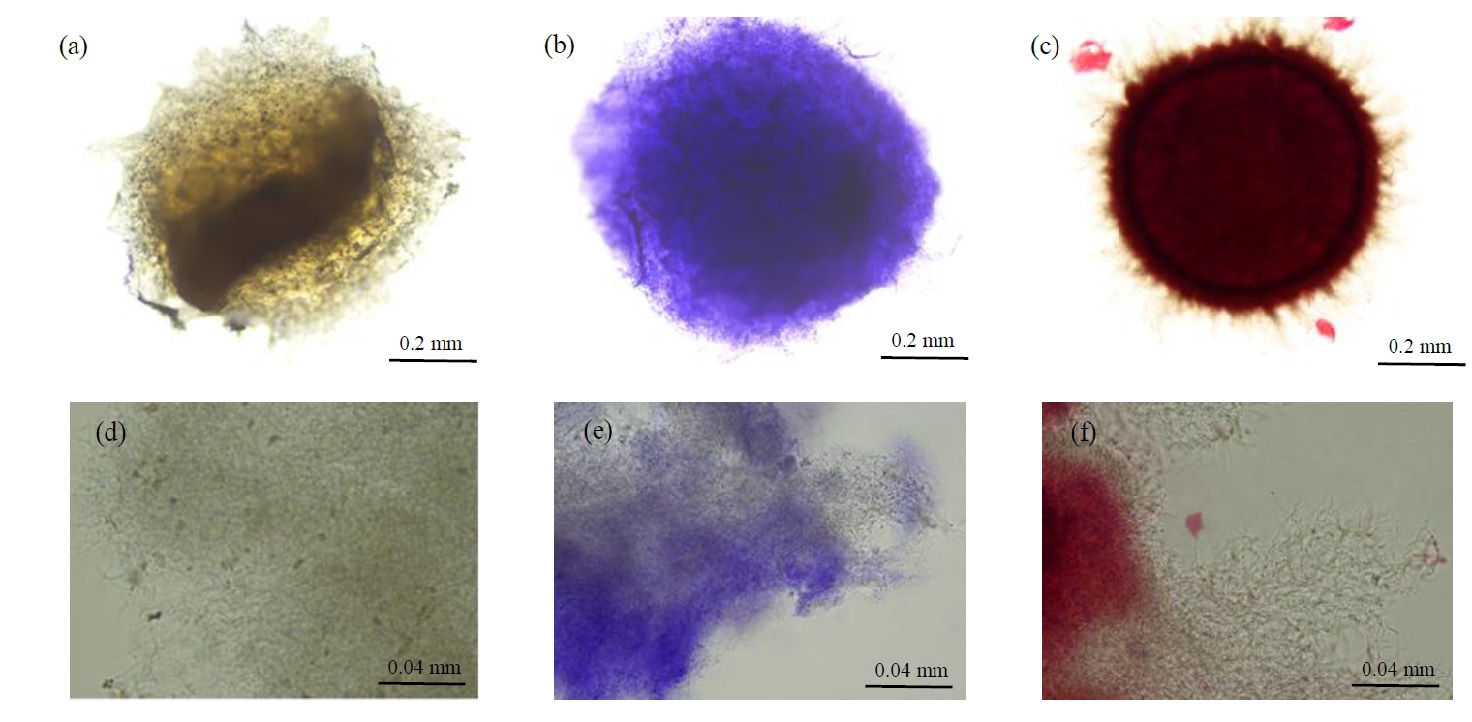Enzymatic Degradation of Azo Bonds and Other Functional Groups on Commercial Silk Dyes by Streptomyces coelicoflavus CS-29 10.32526/ennrj/20/202100104
Main Article Content
Abstract
Azo dyes are used for silk textile manufacture, where their decolorization and detoxication are necessary after initial dying in the craft industry. The bio-decolorization efficiency of Streptomyces coelicoflavus CS-29 toward commercial azo blue and red dyes was investigated, analyzing the degradation and adsorption of dye molecules. S. coelicoflavus CS-29 showed reductions of 70% and 51% in red and blue dyes, respectively, after seven days. Morphological observation by light microscopy showed that dye molecules were adsorbed onto S. coelicoflavus CS-29 cell surface to form a dense cell pellet. Moreover, peroxidase and laccase activity were detected as extracellular enzymes, but no azo-reductase was detected. From the enzymatic activity, changes of dye profiles in HPLC showed differences between control dyes (untreated dyes) and metabolized products of dyes treated with S. coelicoflavus CS-29. The presence of main functional azo groups (-N=N-) in both blue and red silk dyes was indicated by FTIR analysis, in the untreated azo dyes. The azo bonds seemed to disappear in metabolites after S. coelicoflavus CS-29 treatment and other functional groups were changed compared to the control dyes. The treated dyes showed no significant effect on seed germination, root length, and shoot length of mung beans during phytotoxicity analysis. The red dyes showed a more negative effect on shoot lengths than the blue dyes. The overall results showed that S. coelicoflavus CS-29 is an effective and promising tool for the treatment of dye contaminated wastewater and the permanent elimination of recalcitrant commercial azo dye pollutants.
Article Details
Published articles are under the copyright of the Environment and Natural Resources Journal effective when the article is accepted for publication thus granting Environment and Natural Resources Journal all rights for the work so that both parties may be protected from the consequences of unauthorized use. Partially or totally publication of an article elsewhere is possible only after the consent from the editors.
References
Adenan NH, Lim Y, Ting AS. Identification and optimization of triphenylmethane dyes removal by Streptomyces sp. from forest soil. Sustainable Environment Research 2021;31: Article No. 8.
Bankole PO, Adekunle AA, Govindwar SP. Enhanced decolorization and biodegradation of acid red 88 dye by newly isolated fungus, Achaetomium strumarium. Journal of Environmental Chemical Engineering 2018;6:1589-600.
Benkhaya S, Rabetb SM, Harf A. A review on classifications, recent synthesis and applications of textile dyes. Inorganic Chemistry Communications 2020;115:Article No. 107891.
Blánquez A, Rodríguez J, Brissos V, Mendes S, Martins L, Ball A, et al. Decolorization and detoxification of textile dyes using a versatile Streptomyces laccase-natural mediator system. Saudi Journal of Biology Science 2019;26(5):913-20.
Buntić AV, Pavlović MD, Antonović DG, Šiler-Marinković SS, Dimitrijević-Branković SI. A treatment of wastewater containing basic dyes by the use of new strain Streptomyces microflavus CKS6. Journal of Cleaner Production 2017; 148:347-54.
European and Mediterranean Plant Protection Organization (EPPO). Efficacy evaluation of plant protection products: Phytotoxicity assessment. OEPP/EPPO Bulletin 2007;37:4-10.
Garg SK, Tripathi M. Microbial strategies for discoloration and detoxification of azo dyes from textile effluents. Research Journal of Microbiology 2017;12(1):1-19.
Kurade MB, Waghmode TR, Khandare RV, Jeon BH, Govindwar SP. Biodegradation and detoxification of textile dye disperse red 54 by Brevibacillus laterosporus and determination of its metabolic fate. Journal of Bioscience and Bioengineering 2016;121(4):442-9.
Leelakriangsak M, Borisut S. Characterization of the decolorizing activity of azo dyes by Bacillus subtilis azoreductase AzoR1. Songklanakarin Journal Science Technology 2012;34(5): 509-16.
Li S, Huang J, Mao J, Zhang L, He C, Chen G, et al. In vivo and in vitro efficient textile wastewater remediation by Aspergillus niger biosorbent. Nanoscale Advances 2019;1:168-76.
Mon WP, Boonlue S, Mongkolthanaruk W. Investigation of Streptomyces for reduction of commercial silk dyes. Korean Journal of Microbiology 2020;56(3):206-13.
Mongkolthanaruk W, Tongbopit S, Bhoonobtong A. Independent behavior of bacterial laccases to inducers and metal ions during production and activity. African Journal of Biotechnology 2012;11(39):9391-8.
Pandey A, Singh P, Iyengar L. Bacterial decolorization and degradation of azo dyes. International Biodeterioration and Biodegradation 2007;59:73-84.
Pasti-Grigsby MB, Burke NS, Goszczynski S, Crawford DL. Transformation of azo dye isomers by Streptomyces chromofuscus A11. Applied and Environmental Microbiology 1996;62:1814-7.
Rahman A, Rayhan YH, Chowdhury AH, Mohiuddin KM. Phytotoxic effect of synthetic dye effluents on seed germination and early growth of red amaranth. Fundamental and Applied Agriculture 2018;3(2):480-90.
Saratale RG, Gandhi SS, Purankar MV, Kurade MB, Govindwar SP, Oh SE, et al. Decolorization and detoxification of sulfonated azo dye C.I. remazol red and textile effluent by isolated Lysinibacillus sp. RGS. Journal of Bioscience and Bioengineering 2013;115(6):658-67.
Sarayu K, Sandhya S. Aerobic biodegradation pathway for remazol orange by Pseudomonas aeruginosa. Applied Biochemistry and Biotechnology 2010;160:1241-53.
Sari IP, Simarani K. Comparative static and shaking culture of metabolite derived from methyl red degradation by Lysinibacillus fusiformis strain W1B6. Royal Society Open Science 2019;6:Article No. 190152.
Singh RL, Singh PK, Singh RP. Enzymatic decolorization and degradation of azo dyes: A review. International Biodeterioration and Biodegradation 2015;104:21-31.
Sinha A, Osborne WJ. Biodegradation of reactive green dye (RGD) by indigenous fungal strain VITAF-1. International Biodeterioration and Biodegradation 2016;114:176-83.
Sofu A. Investigation of dye removal with isolated biomasses from whey wastewater. International Journal of Environmental Science and Technology 2019;16:71-8.
Stolz A. Basic and applied aspects in the microbial degradation of azo dyes. Applied Microbiology and Biotechnology 2001; 56:69-80.
Zacchetti B, Smits P, Claessen D. Dynamics of pellet fragmentation and aggregation in liquid-grown cultures of Streptomyces lividans. Frontiers in Microbiology 2018;9: Article No. 943.
Zhou W, Zimmermann W. Decolorization of industrial effluents containing reactive dyes by actinomycetes. FEMS Microbiology Letters 1993;107:157-62.

